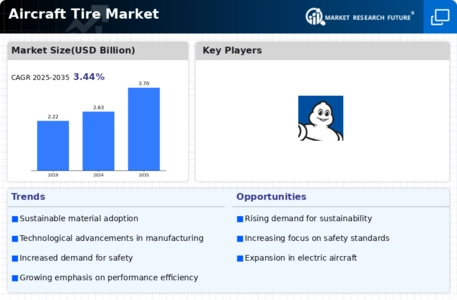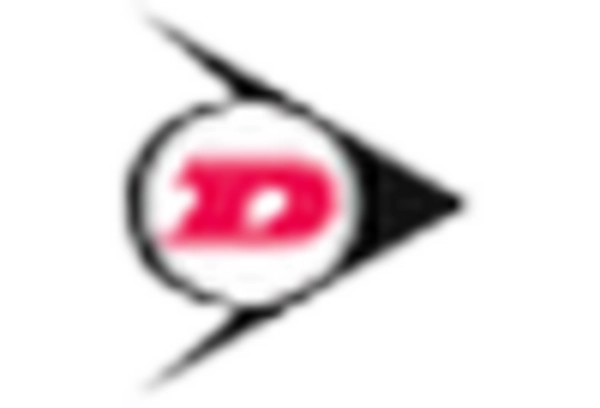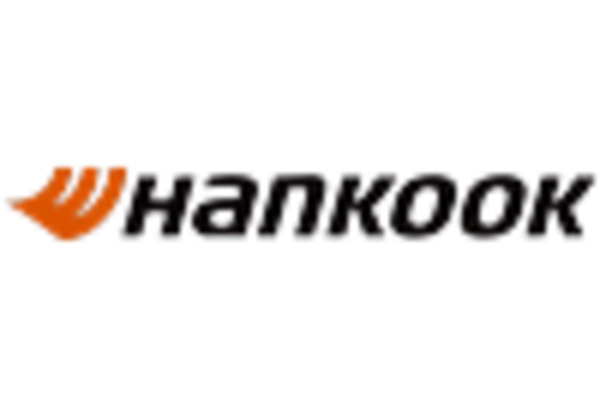-
Executive Summary
-
Market Attractiveness Analysis
- Global Aircraft Tire Market, By Platform
- Global Aircraft Tire Market, By Product Type
- Global Aircraft Tire Market, By Aircraft Type
- Global Aircraft Tire Market, By End User
- Global Aircraft Tire Market, By Region
-
Market Introduction
-
Market Definition
-
Scope Of The Study
-
Market Structure
-
Key Buying Criteria
-
Market Factor Indicator Analysis
-
Research Methodology
-
Research Process
-
Primary Research
-
Secondary Research
-
Market Size Estimation
-
Forecast Model
-
List Of Assumptions
-
Market Insights
-
Market Dynamics
-
Introduction
-
Drivers
-
Restraints
-
Opportunities
-
Challenges
-
Market/Technological Trends
-
Patent Trends
-
Regulatory Landscape/Standards
-
Market Factor Analysis
-
Value Chain/Supply Chain Analysis
- R&D
- Manufacturing
- Distribution & Sales
- Post-Sales Monitoring
-
Porter’s Five Forces Analysis
- Threat Of New Entrants
- Bargaining Power Of Buyers
- Threat Of Substitutes
- Intensity Of Rivalry
- Bargaining Power Of Suppliers
-
Global Aircraft Tire Market, By Platform
-
Introduction
-
Fixed-Wing
- Market Estimates & Forecast, 2025-2034
- Market Estimates & Forecast, By Region, 2025-2034
-
Rotary-Wing
- Market Estimates & Forecast, 2025-2034
- Market Estimates & Forecast, By Region, 2025-2034
-
Global Aircraft Tire Market, By Aircraft Type
-
Introduction
-
Commercial Aircraft
- Market Estimates & Forecast, 2025-2034
- Market Estimates & Forecast, By Region, 2025-2034
-
Military Aircraft
- Market Estimates & Forecast, 2025-2034
- Market Estimates & Forecast, By Region, 2025-2034
-
Business & General Aviation Aircraft
- Market Estimates & Forecast, 2025-2034
- Market Estimates & Forecast, By Region, 2025-2034
-
Global Aircraft Tire Market, By Product Type
-
Introduction
-
Bias Ply
- Market Estimates & Forecast, 2025-2034
- Market Estimates & Forecast, By Region, 2025-2034
-
Radial Ply
- Market Estimates & Forecast, 2025-2034
- Market Estimates & Forecast, By Region, 2025-2034
-
Global Aircraft Tire Market, By End User
-
Introduction
-
OEM
- Market Estimates & Forecast, 2025-2034
- Market Estimates & Forecast, By Region, 2025-2034
-
Aftermarket
- Market Estimates & Forecast, 2025-2034
- Market Estimates & Forecast, By Region, 2025-2034
-
Global Aircraft Tire Market, By Region
-
Introduction
-
North America
- Market Estimates & Forecast, By Country, 2025-2034
- Market Estimates & Forecast, By Platform, 2025-2034
- Market Estimates & Forecast, By Product Type, 2025-2034
- Market Estimates & Forecast, By End User, 2025-2034
- Market Estimates & Forecast, By Aircraft Type, 2025-2034
- US
- Canada
-
Europe
- Market Estimates & Forecast, By Country, 2025-2034
- Market Estimates & Forecast, By Platform, 2025-2034
- Market Estimates & Forecast, By Product Type, 2025-2034
- Market Estimates & Forecast, By End User, 2025-2034
- UK
- Germany
- France
- Spain
- Rest Of Europe
-
Asia-Pacific
- Market Estimates & Forecast, By Country, 2025-2034
- Market Estimates & Forecast, By Platform, 2025-2034
- Market Estimates & Forecast, By Product Type, 2025-2034
- Market Estimates & Forecast, By End User, 2025-2034
- Market Estimates & Forecast, By Aircraft Type, 2025-2034
- China
- Japan
- India
- South Korea
- Rest Of Asia-Pacific
-
Middle East & Africa
- Market Estimates & Forecast, By Country, 2025-2034
- Market Estimates & Forecast, By Platform, 2025-2034
- Market Estimates & Forecast, By Product Type, 2025-2034
- Market Estimates & Forecast, By End User, 2025-2034
- Market Estimates & Forecast, By Aircraft Type, 2025-2034
- UAE
- Saudi Arabia
- Rest Of The Middle East & Africa
-
Latin America
- Market Estimates & Forecast, By Country, 2025-2034
- Market Estimates & Forecast, By Platform, 2025-2034
- Market Estimates & Forecast, By Product Type, 2025-2034
- Market Estimates & Forecast, By End User, 2025-2034
- Market Estimates & Forecast, By Aircraft Type, 2025-2034
- Brazil
- Mexico
- Rest Of Latin America
-
Competitive Landscape
-
Competitive Overview
-
Competitor Dashboard
-
Major Growth Strategies In The Global Aircraft Tire Market
-
Competitive Benchmarking
-
Market Share Analysis
-
Bridgestone Corporation: The Leading Player In Terms Of Number Of Developments In The Global Aircraft Tire Market
-
Key Developments & Growth Strategies
- Product Type Launches/Service Deployments
- Mergers & Acquisitions
- Joint Ventures
-
Company Profiles
-
Bridgestone Corporation
- Company Overview
- Products/Services Offered
- Financial Overview
- Key Developments
- SWOT Analysis
- Key Strategies
-
Dunlop Aircraft Tyres Limited
- Company Overview
- Products/Services Offered
- Financial Overview
- Key Developments
- SWOT Analysis
- Key Strategies
-
Desser Tire & Rubber Co., LLC
- Company Overview
- Products/Services Offered
- Financial Overview
- Key Developments
- SWOT Analysis
- Key Strategies
-
Michelin Group
- Company Overview
- Products/Services Offered
- Financial Overview
- Key Developments
- SWOT Analysis
- Key Strategies
-
Petlas
- Company Overview
- Products/Services Offered
- Financial Overview
- Key Developments
- SWOT Analysis
- Key Strategies
-
Qingdao Sentury Tire Co., Ltd.
- Company Overview
- Products/Services Offered
- Financial Overview
- Key Developments
- SWOT Analysis
- Key Strategies
-
Sentury Tire
- Company Overview
- Products/Services Offered
- Financial Overview
- Key Developments
- SWOT Analysis
- Key Strategies
-
Specialty Tires Of America, Inc.
- Company Overview
- Products/Services Offered
- Financial Overview
- Key Developments
- SWOT Analysis
- Key Strategies
-
The Goodyear Tire & Rubber Company
- Company Overview
- Products/Services Offered
- Financial Overview
- Key Developments
- SWOT Analysis
- Key Strategies
-
WILKERSON COMPANY, INC.
- Company Overview
- Products/Services Offered
- Financial Overview
- Key Developments
- SWOT Analysis
- Key Strategies
-
Appendix
-
References
-
Related Reports
-
List Of Abbreviations
-
Industry Insights
-
List Of Tables
-
Global Aircraft Tire Market, By Region, 2025-2034
-
North America: Aircraft Tire Market, By Country, 2025-2034
-
Europe: Aircraft Tire Market, By Country, 2025-2034
-
Asia-Pacific: Aircraft Tire Market, By Country, 2025-2034
-
Middle East & Africa: Aircraft Tire Market, By Country, 2025-2034
-
Latin America: Aircraft Tire Market, By Country, 2025-2034
-
Global Aircraft Tire Market Size, By Region, 2025-2034
-
North America: Aircraft Tire Market Size, By Country, 2025-2034
-
Europe: Aircraft Tire Market Size, By Country, 2025-2034
-
Asia-Pacific: Aircraft Tire Market Size, By Country, 2025-2034
-
Middle East & Africa: Aircraft Tire Market Size, By Country, 2025-2034
-
Latin America: Aircraft Tire Market Size, By Country, 2025-2034
-
Global Aircraft Tire Platform Market, By Region, 2025-2034
-
North America: Aircraft Tire Platform Market, By Country, 2025-2034
-
Europe: Aircraft Tire Platform Market, By Country, 2025-2034
-
Asia-Pacific: Aircraft Tire Platform Market, By Country, 2025-2034
-
Middle East & Africa: Aircraft Tire Platform Market, By Country, 2025-2034
-
Latin America: Aircraft Tire Platform Market, By Country, 2025-2034
-
Global Aircraft Tire Product Type Market, By Region, 2025-2034
-
North America: Aircraft Tire Product Type Market, By Country, 2025-2034
-
Europe: Aircraft Tire Product Type Market, By Country, 2025-2034
-
Asia-Pacific: Aircraft Tire Product Type Market, By Country, 2025-2034
-
Middle East & Africa: Aircraft Tire Product Type Market, By Country, 2025-2034
-
Latin America: Aircraft Tire Product Type Market, By Country, 2025-2034
-
Global Aircraft Tire End User Market, By Region, 2025-2034
-
North America: Aircraft Tire End User Market, By Country, 2025-2034
-
Europe: Aircraft Tire End User Market, By Country, 2025-2034
-
Asia-Pacific: Aircraft Tire End User Market, By Country, 2025-2034
-
Middle East & Africa: Aircraft Tire End User Market, By Country, 2025-2034
-
Latin America: Aircraft Tire End User Market, By Country, 2025-2034
-
Global Aircraft Tire Aircraft Type Market, By Region, 2025-2034
-
North America: Aircraft Tire Aircraft Type Market, By Country, 2025-2034
-
Europe: Aircraft Tire Aircraft Type Market, By Country, 2025-2034
-
Asia-Pacific: Aircraft Tire Aircraft Type Market, By Country, 2025-2034
-
Middle East & Africa: Aircraft Tire Aircraft Type Market, By Country, 2025-2034
-
Latin America: Aircraft Tire Aircraft Type Market, By Country, 2025-2034
-
Global Aircraft Tire Market, By Region, 2025-2034
-
Global Aircraft Tire Market, By Platform, 2025-2034
-
Global Aircraft Tire Market, By Product Type, 2025-2034
-
Global Aircraft Tire Market, By End User, 2025-2034
-
Global Aircraft Tire Market, By Aircraft Type, 2025-2034
-
North America: Aircraft Tire Market, By Country, 2025-2034
-
North America: Aircraft Tire Market, By Platform, 2025-2034
-
North America: Aircraft Tire Market, By Product Type, 2025-2034
-
North America: Aircraft Tire Market, By End User, 2025-2034
-
North America: Aircraft Tire Market, By Aircraft Type, 2025-2034
-
Europe: Aircraft Tire Market, By Country, 2025-2034
-
Europe: Aircraft Tire Market, By Platform, 2025-2034
-
Europe: Aircraft Tire Market, By Product Type, 2025-2034
-
Europe: Aircraft Tire Market, By End User, 2025-2034
-
Europe: Aircraft Tire Market, By Aircraft Type, 2025-2034
-
Asia-Pacific: Aircraft Tire Market, By Country, 2025-2034
-
Asia-Pacific: Aircraft Tire Market, By Platform, 2025-2034
-
Asia-Pacific: Aircraft Tire Market, By Product Type, 2025-2034
-
Asia-Pacific: Aircraft Tire Market, By End User, 2025-2034
-
Asia-Pacific: Aircraft Tire Market, By Aircraft Type, 2025-2034
-
Middle East & Africa: Aircraft Tire Market, By Country, 2025-2034
-
Middle East & Africa: Aircraft Tire Market, By Platform, 2025-2034
-
Middle East & Africa: Aircraft Tire Market, By Product Type, 2025-2034
-
Middle East & Africa: Aircraft Tire Market, By End User, 2025-2034
-
Middle East & Africa: Aircraft Tire Market, By Aircraft Type, 2025-2034
-
Latin America: Aircraft Tire Market, By Country, 2025-2034
-
Latin America: Aircraft Tire Market, By Platform, 2025-2034
-
Latin America: Aircraft Tire Market, By Product Type, 2025-2034
-
Latin America: Aircraft Tire Market, By End User, 2025-2034
-
Latin America: Aircraft Tire Market, By Aircraft Type, 2025-2034
-
List Of Figures
-
Research Process Of MRFR
-
Top-Down And Bottom-Up Approaches
-
Market Dynamics
-
Impact Analysis: Market Drivers
-
Impact Analysis: Market Restraints
-
Porter's Five Forces Analysis
-
Value Chain Analysis
-
Global Aircraft Tire Market Share, By Platform, 2024 (%)
-
Global Aircraft Tire Market, By Platform, 2025-2034 (USD Billion)
-
Global Aircraft Tire Market Share, By Product Type, 2024 (%)
-
Global Aircraft Tire Market, By Product Type, 2025-2034 (USD Billion)
-
Global Aircraft Tire Market Share, By End User, 2024 (%)
-
Global Aircraft Tire Market, By End User, 2025-2034 (USD Billion)
-
Global Aircraft Tire Market Share, By Aircraft Type, 2024 (%)
-
Global Aircraft Tire Market, By Aircraft Type, 2025-2034 (USD Billion)
-
Global Aircraft Tire Market Share (%), By Region, 2024
-
Global Aircraft Tire Market, By Region, 2025-2034 (USD Billion)
-
North America: Aircraft Tire Market Share (%), 2024
-
North America: Aircraft Tire Market, By Country, 2025-2034 (USD Billion)
-
Europe: Aircraft Tire Market Share (%), 2024
-
Europe: Aircraft Tire Market, By Country, 2025-2034 (USD Billion)
-
Asia-Pacific: Aircraft Tire Market Share (%), 2024
-
Asia-Pacific: Aircraft Tire Market, By Country, 2025-2034 (USD Billion)
-
Middle East & Africa: Aircraft Tire Market Share (%), 2024
-
Middle East & Africa: Aircraft Tire Market, By Country, 2025-2034 (USD Billion)
-
Latin America: Aircraft Tire Market Share (%), 2024
-
Latin America: Aircraft Tire Market, By Country, 2025-2034 (USD Billion)

















Leave a Comment